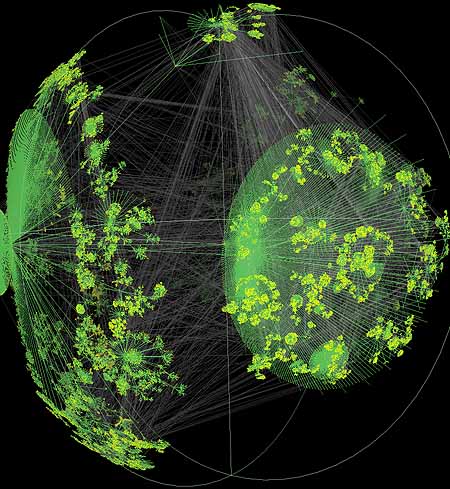Sunday, 25 March 2007
Module 2 - Chat Task
Although 'advanced netstudies' returned nothing when searching via the ICQ console or the ICQ website, I found an ICQ number for 'netstudies' at curtin was 110032611. Authorisation was not automatic and there was nothing in the notes section - maybe it is an account set up by another student in this unit, or a russian spy, hmm, After reading the discussion boards about this task, I don't even know if this is part of the unit. Oddly, when I cheat and do the self test the correct answer is 257853416 which in turn can be used to find the user 'advanced netstudies' which contains within the about section "This is the ICQ identity I use just for my 'advanced internet use' students!"
Module 2 - Lists Tasks
It is a list detailing concerns within the advertising and design industry. I had subscribed to other lists but found the content usually become too long winded and the relevancy to what I was looking for decreased along with my interest. Generally I find that lists are not an time effective way of finding the most accurate information about any given topic and I have found that it is almost always better to bookmark a site of interest and check it regularly when I am interested in finding out about that topic. My online activities just take up too much time as it is to take in the unedited rantings of thousands of list subscribers.
How Newsgroups Work: http://computer.howstuffworks.com/newsgroup1.htm
What are the pros and cons of email lists versus discussion boards?
I have found that both of these formats mean that there are many unrelated messages to the topic under discussion. Advantages of a list is that it is often edited, thus removing some of these messages, and that because the information is on your computer, it is often faster to pass over info that does not interest you. An advantage of a discussion board is that you have chosen to be there at that time so you have more of an idea about what information is relevant at that time and also, a discussion board allows you more control over what 'threads' you chose to read more thoroughly.
Are there certain kinds of communication or purposes more suited to one than the other?
Discussion boards are both 'synchronous' and 'asynchronous' - the information is updated and available in real time, but remains visible over a period of time and can be most useful when personal opinion or experience is sought. Factual news reports or news from a reputable organisation work well as a list because they are usually edited so that the information is more reliable. Conversely, they could be edited to reflect the list administrators' point of view. When users contribute to a discussion board (or unedited list) the info tends to become more personal opinion than actual news and from my point of view often has less relevance. If there is a tight knit group involved in a discussion board, it works well because information is relayed in real time and also, the end user may value the direct input of another specific contributor.
Module 2 - Email Tasks
Looking at an email message, we can find information about the user's 'username' and the domain from which it was sent. From this we can often discover details of the user's full name if addressed in the form of jsmith, john.smith or johns for example, but this would be an unreliable method due to the wide range of naming options available. Also, we might often discover some details about the origin of the message from the domain information, ie. @bigpond.com.au would originate from an Australian ISP. Again, due to the nature of the internet, this is unreliable and there is no way to determine if the message was actually sent from any physical location - the sender may be diverting the message from another address or could even be on holiday overseas and using webmail. If we view the "header" information within a message we can see further information that looks like:
From: support_registration@icq.com
Subject: Welcome New ICQ User!
Date: 25 March 2007 10:59:08 PM
To: atype@people.net.au
Return-Path:
Delivered-To: atype@people.net.au
Received: (qmail 12975 invoked from network); 25 Mar 2007 13:00:27 -0000
Received: from mailgate-02.peopletelecom.com.au ([218.214.224.100]) (envelope-sender
Received: from postman6.mx.aol.com (postman6.mx.aol.com [205.188.157.129]) (using TLSv1 with cipher DHE-RSA-AES256-SHA (256/256 bits)) (No client certificate requested) by mailgate-02.peopletelecom.com.au (Spam Firewall) with ESMTP id 2118136994D for
Received: from localhost (owslbfa1-dtc-sip15.net.aol.com [205.188.182.15]) by postman6.mx.aol.com (8.13.1/8.13.1) with SMTP id l2PCx8io007460 for
X-Asg-Debug-Id: 1174827554-544d00630000-TAYmQj
X-Barracuda-Url: http://mailgate-02.peopletelecom.com.au:8000/cgi-bin/mark.cgi
X-Barracuda-Connect: postman6.mx.aol.com[205.188.157.129]
X-Barracuda-Start-Time: 1174827554
X-Barracuda-Encrypted: DHE-RSA-AES256-SHA
Message-Id: <200703251259.l2pcx8io007460@postman6.mx.aol.com>
X-Asg-Orig-Subj: Welcome New ICQ User!
X-Barracuda-Bayes: INNOCENT GLOBAL 0.0000 1.0000 -2.0210
X-Barracuda-Virus-Scanned: by People Telecom Spam Firewall at peopletelecom.com.au
X-Barracuda-Spam-Score: -1.52
X-Barracuda-Spam-Status: No, SCORE=-1.52 using global scores of TAG_LEVEL=3.5 QUARANTINE_LEVEL=1000.0 KILL_LEVEL=6.0 tests=BSF_RULE7568M
X-Barracuda-Spam-Report: Code version 3.1, rules version 3.1.12256 Rule breakdown below pts rule name description ---- ---------------------- -------------------------------------------------- 0.50 BSF_RULE7568M BODY: Custom Rule 7568M
2. In what cases would you find it useful to use the 'cc', 'bcc' and 'reply all functions of email?
- 'cc' stands for 'carbon copy' and is used to send an identical message to users other than the primary recipient. Often, those who are cc'd on a message are not expected to take the same action as the primary recipient, but need to know the communication has taken place.
- 'bcc' stands for 'blind carbon copy'. This means that their address information will not be available to other recipients of your message and could be useful for preventing the widespread distribution of spam, or hiding the identity of those recipients (or the fact that the message has been seen by those recipients).
- 'reply all' sends a copy of your reply to all accounts that were included as adressees of the original message you are replying to. ('reply' just sends a reply to the sender of the message.)
- We can ensure attachments are received in the format they are intended by co-ordinating the encoding method within the users email client. The most effective method is MIME.
- Usually, the recipient will need also to have the same software installed on their computer as the person who created the file, particularly for documents that originated in word, photoshop, illustrator, indesign, quark etc.
- Often, there are problems between systems used ie, Mac vs. PC files.
- It may be a good idea to include complete information about the origin of the file within the body of the email, ie. "Please find file attached, Example.doc (Windows 2000/Microsoft Word 6.0."
- Large files should be compressed using software such as Winzip or Stuffit - as long as the recipient has the neccessary software to decompress them.
- A PDF document is a reliable way to send an attachment for wysiwyg viewing but may not be editable by the recipient unless they have the correct software and/or password.
- It is possible for a problem to occur when a file is encoded in ASCII format from the program that created it, ie. if an EPS file from Photoshop is encoded using ASCII formatting it may disply incorrectly (as characters instead of an image) when sent as an attachment in an email.
I don't really filter my email too thoroughly because I don't recieve a lot of unsolicited mail. If anything I ask my email application to class certain senders as 'spam' and I unsubscribe to messages that I might receive from unwanted senders.
5. How have you organised the folder structure of your email and why?
My friends are grouped into a 'friends' folder so I can keep track of them easily. I also have a 'work' folder for similar reasons and a 'web' folder that I group messages from lists I have subscribed to or when a website I have used sends me a message.
Wednesday, 7 March 2007
Ping vs. Traceroute
Ping is a basic Internet program that allows a user to verify that a particular IP address exists and can accept requests. The verb ping means the act of using the ping utility or command. Ping is used diagnostically to ensure that a host computer you are trying to reach is actually operating. If, for example, a user can't ping a host, then the user will be unable to use the File Transfer Protocol (FTP) to send files to that host. Ping can also be used with a host that is operating to see how long it takes to get a response back. Using ping, you can learn the number form of the IP address from the symbolic domain name.
Traceroute
Traceroute is a utility that records the route (the specific gateway computers at each hop) through the Internet between your computer and a specified destination computer. It also calculates and displays the amount of time each hop took. Traceroute is a handy tool both for understanding where problems are in the Internet network and for getting a detailed sense of the Internet itself. Another utility, ping, is often used prior to using traceroute to see whether a host is present on the network.
Extracts from http://whatis.techtarget.com
Monday, 5 March 2007
Module 1:Tasks
Searching for books on the Deakin library, I found 2, my result was
You searched for the AUTHOR: bennahum Deakin/Gordon:All Locations
2 AUTHORS found, with 2 entries; AUTHORS 1-2 are:
1 Bennahum David A 1936 ................................. 1 entry
2 Bennahum Ninotchka .................................... 1 entry
The title was Managed Care: financial, legal and ethical issues
...and although I think Star Wars IV is the best movie ever, the blinkenlights version left me a bit cold, although Mark Hamill's acting seemed better than the original version, the special effects just weren't up to scratch 8)
FTP Task:
Because the files are hosted on a unix platform CAPITALIZATION matters.
Traceroute Task
As ever wikipedia is a great way to start a search for info, especially if its techo related - here I tried http://en.wikipedia.org/wiki/Traceroute
From the Network-tools website, the result was:
TraceRoute to 134.7.179.10 [curtin.edu.au]
Hop (ms) (ms) (ms) IP Address Host name
1 1 0 0 66.98.244.1 gphou-66-98-244-1.ev1servers.net
2 1 1 0 66.98.241.16 gphou-66-98-241-16.ev1servers.net
3 0 0 0 66.98.240.12 gphou-66-98-240-12.ev1servers.net
4 1 1 1 129.250.11.129 ge-1-11.r03.hstntx01.us.bb.gin.ntt.net
5 2 2 2 129.250.2.228 xe-0-1-0.r20.hstntx01.us.bb.gin.ntt.net
6 37 37 38 129.250.4.112 p64-1-3-0.r21.lsanca03.us.bb.gin.ntt.net
7 37 77 37 129.250.3.159 p16-1-0-0.r02.lsanca03.us.bb.gin.ntt.net
8 196 196 196 198.172.90.102 so-2-1-0.a00.lsanca02.us.ce.verio.net
9 200 200 200 202.158.194.153 so-3-2-0.bb1.b.syd.aarnet.net.au
10 212 212 212 202.158.194.33 so-2-0-0.bb1.a.mel.aarnet.net.au
11 221 221 221 202.158.194.17 so-2-0-0.bb1.a.adl.aarnet.net.au
12 248 248 248 202.158.194.5 so-0-1-0.bb1.a.per.aarnet.net.au
13 248 248 248 202.158.198.178 gigabitethernet0.er1.curtin.cpe.aarnet.net.au
14 248 248 248 202.158.198.186 gw1.er1.curtin.cpe.aarnet.net.au
15 248 248 248 134.7.250.18 -
16 248 248 248 134.7.248.65 te1-1.b309-sr.net.curtin.edu.au
17 249 248 249 134.7.179.10 prodweb1.curtin.edu.au
When I ran a traceroute from my desktop, the result was:
traceroute to curtin.edu.au (134.7.179.10), 64 hops max, 40 byte packets
1 192.168.0.1 (192.168.0.1) 1.382 ms 4.606 ms 1.502 ms
2 202-154-95-181.people.net.au (202.154.95.181) 13.225 ms 12.906 ms 12.863 ms
3 vic-gw-cty-01-g-0-2-10.people.net.au (218.214.17.251) 12.647 ms 17.014 ms 15.978 ms
4 302-ge0-0-0.gw4.mel1.alter.net (203.166.42.121) 15.916 ms 16.646 ms 20.998 ms
5 324.at-3-0-0.xr2.mel1.alter.net (210.80.33.165) 16.242 ms 17.864 ms 15.531 ms
6 0.so-7-0-0.xt2.syd2.alter.net (210.80.32.229) 26.862 ms 29.448 ms 28.677 ms
7 so-7-0-0.br2.syd2.alter.net (210.80.33.238) 28.401 ms 30.450 ms 30.587 ms
8 gigabitethernet2-0-0.pe1.c.syd.aarnet.net.au (203.103.244.194) 27.305 ms 29.237 ms 28.692 ms
9 ge-1-0-5.bb1.b.syd.aarnet.net.au (202.158.202.22) 30.859 ms 28.385 ms 28.472 ms
10 so-2-0-0.bb1.a.mel.aarnet.net.au (202.158.194.33) 41.293 ms 41.961 ms 40.624 ms
11 so-2-0-0.bb1.a.adl.aarnet.net.au (202.158.194.17) 50.394 ms 52.110 ms 51.292 ms
12 so-0-1-0.bb1.a.per.aarnet.net.au (202.158.194.5) 79.390 ms 80.244 ms 78.246 ms
13 gigabitethernet0.er1.curtin.cpe.aarnet.net.au (202.158.198.178) 78.884 ms 77.571 ms 78.071 ms
14 gw1.er1.curtin.cpe.aarnet.net.au (202.158.198.186) 79.085 ms 76.608 ms 79.458 ms
15 134.7.250.18 (134.7.250.18) 77.598 ms 78.498 ms 74.944 ms
16 te1-1.b309-sr.net.curtin.edu.au (134.7.248.65) 76.425 ms 78.229 ms 76.618 ms
The average hop time over 16 hops was 4.788 ms.
Interesting, because a traceroute run from visualroute.visualware.com servers in the US only used 14 hops, but took 298 ms to get there... go figure.
Ping Task
I had trouble Ping'ing the actual webct site from network tools so decided to Ping the curtin.edu.au site. I got these results:
Round trip time to 134.7.179.10: 248 ms
Round trip time to 134.7.179.10: 249 ms
Round trip time to 134.7.179.10: 248 ms
Round trip time to 134.7.179.10: 248 ms
Round trip time to 134.7.179.10: 248 ms
Round trip time to 134.7.179.10: 248 ms
Round trip time to 134.7.179.10: 248 ms
Round trip time to 134.7.179.10: 249 ms
Round trip time to 134.7.179.10: 249 ms
Round trip time to 134.7.179.10: 249 ms
Average time over 10 pings: 248.4 ms
And from my computer using Terminal I got:
64 bytes from 134.7.179.10: icmp_seq=0 ttl=244 time=79.398 ms
64 bytes from 134.7.179.10: icmp_seq=1 ttl=244 time=78.154 ms
64 bytes from 134.7.179.10: icmp_seq=2 ttl=244 time=79.432 ms
64 bytes from 134.7.179.10: icmp_seq=3 ttl=244 time=79.159 ms
64 bytes from 134.7.179.10: icmp_seq=4 ttl=244 time=81.086 ms
64 bytes from 134.7.179.10: icmp_seq=5 ttl=244 time=78.634 ms
64 bytes from 134.7.179.10: icmp_seq=6 ttl=244 time=79.073 ms
64 bytes from 134.7.179.10: icmp_seq=7 ttl=244 time=76.830 ms
64 bytes from 134.7.179.10: icmp_seq=8 ttl=244 time=78.869 ms
64 bytes from 134.7.179.10: icmp_seq=9 ttl=244 time=79.146 ms
The average time was significantly faster from my desktop, which I would expect because of the geographical difference between the two servers along with, I guess, the much lower volume of overall traffic the packets would encounter along the way. Interestingly, the difference in speeds correlate quite accurately with the differences in speed in the traceroute task - I guess that the traceroute is actually just Pinging the server anyway but also logging the servers encountered along the way.
AWESOME WEBSITE DISCOVERED!
http://www.caida.org
'Skitter' data is collected by sending packets in a similar manner to traceroute, where it can be measured in terms of its path, 'hops' taken and round-trip time to develop a fuller picture of the network that has been utilised in its 'journey'. Network characteristics can then be analysed and information on routing changes and IP connectivity can be gauged by comparing output skitter graphs.

Module 1: Servers & Clients
- The protocol ("http")
- The server name ("www.howstuffworks.com")
- The file name ("web-server.htm")
Module 1: Concepts (Extracts from NET11 text)
23. Human-computer interfaces
The Internet was originally designed to enable humans to instruct computers to act at a distance. The Internet still has this capacity; thus, we begin to see the emergence of a cultural sensibility in which the hard and fast distinctions between humans and computers as different kinds of ‘communicating devices’ breaks down. Telnet and similar functions on the Internet are different to programming and interacting with a computer on your desktop because you can’t physically see the computer at the other end of the connection.
This phenomenon has been exploited, for fun and research, by artificial intelligence programmers and language program developers. In one famous case, a ‘bot’ (robot) called Julia was developed (essentially a sophisticated program) that could, via IRC, fool people for at least a little while into believing it was a real human. It has been said that this example proves more about the lack of communication skills of humans than the abilities of computers.
The Internet lessens the recognition of difference between humans and computers because, at a distance, it is often feels similar to communicate and act on the Internet regardless of whether one is speaking with a human or a machine. |
Interacting with websites feels similarly impersonal or, more subtly, further indicates the extent to which humans readily accept the presence of machine-like ‘intelligence’ in their lives.
24. Client-server two-way interactions
File transfer protocol differs most clearly from hypertext transfer protocol (HTTP) – the basis of the World Wide Web – by the fact that it can arranged very easily as a two-way exchange of information in any number of file formats. While many FTP operations only ever take place in one direction (from the server to the client), there are some publically available FTP activities in which clients upload as well as download files. Sometimes this is used for public exchange of information (often for illegal activities, such as trading pirated software between people); more often it is so that a single person can, effectively, manage files on more than one computer (for example, their desktop machine and a server or public machine).
The end result is that, at its heart, the Internet remains a two-way street. Files can be sent as well as received. Moreover, while more often used for limited groups or individuals, FTP remains a public utility, enabling individuals to ‘publish’ material that can be taken, on demand, rather than (as in sending email attachments) being ‘pushed’ at the recipient (in the traditional broadcast model). We see here that FTP is an asynchronous technology: I publish a file and, days, weeks, years later, the recipient can go and collect that file. But it is also a client-driven technology: FTP does not deliver…it fetches.
File transfer protocol remains the best example of how the Internet enables files to be sent to and from clients, at their initiation, thus emphasising the local autonomy of the individual user, and the arrangement of ‘cyberspace’ into publically accessible and changeable regions. |
Two-way communication is the essence of the Internet and there are multiple options for doing it. Almost every form of communication (email, chat, etc) enables users to send large ‘information’ chunks back and forth. The great advantage of the Internet is that, at base, all data is data and so any program which establishes a two-way connection between yourself and another computer/user will – if properly exploited - provide a range of communication options.
25. Identity and location
The absolute, fundamental foundation of the Internet – one which must be maintained at all costs – is a system of identification and location, the creation of fixed, known ‘end points’ at either end of the complex routes taken by packets of data carrying all the information makes up the Internet. Without this fixed system, which must be managed in such a way as to be both usable and expandable (a technical term for this is ‘scalability’), the Internet would not work.
At a technical level, the identity and location system that enables data packets to be routed to and from computers (usually via servers, thence routers, to other servers, thence to personal machines) can assist users in understanding why the Internet seems ‘slow’ or ‘fast’ at certain times and in certain conditions. It could, in some cases, assist users to choose between one or other ISP, or web server. This kind of knowledge, allied to a reading of the ‘names’ in the system, can help users to understand the ownership and control of the Internet and the way it functions as a business system. But more profoundly, the ‘system’ of Internet identity and location suggests a growing change in people’s understandings of the themselves – marked, for example, by the difference between a ‘dynamic’ IP address that changes every time one is online and a ‘static’ address, available to people who run web servers or more expensive fixed, permanent Internet connections.
Advanced Internet users understand the technical system of the Internet, principally its numerical addressing and word-based naming overlay and the way data passes between points in this system. They also understand that this knowledge can assist them in managing their Internet use, and in recognising new cultural developments around the creation of identities that exist in part in physical life and in part in the virtual world. |
Since communication via email or chat or ICQ can occasionally involve unwanted attentions, or misdirected messages, or outright harassment, advanced users learn how to recover key information about location and identity from their communications programs to assist in preventing these activities.
27. The persistence of history
When we consider certain applications, such as telnet, ftp and some of the more arcane ‘management’ tools such as the ability to finger, lookup and so on (so-called net tools), it may appear that, in the age of the World Wide Web, internet telephony, AV conferencing online and so on, these are old-fashioned irrelevancies. However, they are not. These early applications continue to have value, directly, and moreover, advanced Internet users understand them because they provide a sense of history and context which can assist in developing new capabilities for Internet use. Furthermore, the ideas that underlie these technologies are critical and continue to govern the fundamentals of Internet use.
Advanced Internet users inquire into and analyse the kinds of applications available over the Internet, even if they do not regularly use them, so as to learn lessons about past developments and to anticipate potential new developments, based on the meaning of those applications. |
Moreover, while new systems ‘appear’ different, they often use or include much older, traditional applications. For example, various identifier commands (ping, traceroute etc) can be used within IRC; telnet and ftp are tightly interlinked with http for web browsing.
Sunday, 4 March 2007
Hello all
Hmm, what do I expect to get out of this blog, and indeed, this unit NET11, in the end? I don't really feel the need to pour my heart out for the world to hear and my lifes pretty straitforward – work eat sleep, work eat sleep etc (well its not that mundane but you catch my drift), and I once tried to keep a diary but that just became depressing when things didn't go well X/.
What I would like to do with my blog is basically the reason why we are asked to keep one for NET11 anyway – just to keep all my notes, links and stuff in one place. Besides, my desk is just a huge mess and I struggle to even find my notes from the last unit I did. I was going to tidy it up today but ended up throwing out four pairs of shoes instead and then drinking beer and watching TV. Sure, I have a disipline problem sometimes, but now comes the time to do something about it – cue "The Eye of the Tiger".
:D


